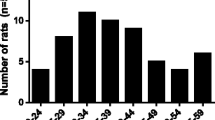Abstract
Rationale: Methylenedioxymethamphetamine (MDMA) is known to damage brain pre-synaptic serotonin (5-HT) neurons. Since loss of 5-HT neurons has been implicated in memory loss, it is important to establish whether MDMA use may produce changes in postsynaptic 5-HT receptors and memory function in humans. Objectives: To investigate whether MDMA use leads to compensative alterations in post-synaptic 5-HT2A receptors and whether there is a relation with memory disturbances. Methods: Brain cortical 5-HT2A receptor densities were studied with [123I]-5-I-R91150 SPECT in five abstinent MDMA users and nine healthy controls. Memory performance was assessed using RAVLT. Results: [123I]-5-I-R91150 binding ratios were significantly higher in the occipital cortex of MDMA users than in controls, indicating up-regulation. Mean cortical 5-HT2A receptor binding correlated positively with RAVLT-recall in MDMA users. Conclusion: Our preliminary results may indicate altered 5-HT neuronal function with correlated memory impairment in abstinent MDMA users.
Similar content being viewed by others
Author information
Authors and Affiliations
Additional information
Received: 20 August 1999 / Final version: 25 November 1999
Rights and permissions
About this article
Cite this article
Reneman, L., Booij, J., Schmand, B. et al. Memory disturbances in ”Ecstasy” users are correlated with an altered brain serotonin neurotransmission. Psychopharmacology 148, 322–324 (2000). https://doi.org/10.1007/s002130050057
Issue Date:
DOI: https://doi.org/10.1007/s002130050057




